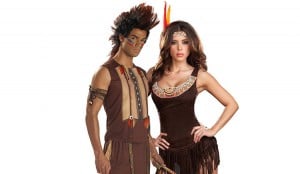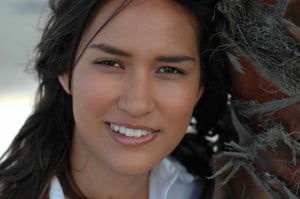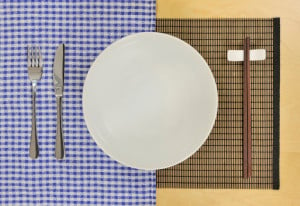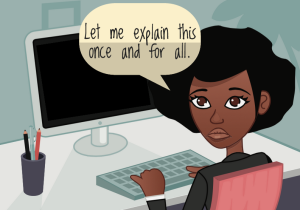
A person lies on their stomach, propping themselves up on their elbows, looking thoughtful.
There are a ton of confusing, harmful, and downright untrue messages about sex in our society.
Growing up, many of us picked them up from our favorite magazines, from watching TV, from out-of-touch sex-ed classes, and from peers who are learning just like us.
Even the people who have our best interests at heart sometimes steer us wrong when sitting us down for “the talk.”
As a young black girl in grade school, I learned many ideas about sex and sexuality that I now know to be absolute BS – and I learned them from family and friends who were trying to look out for me.
Luckily, feminism taught me better. After taking a women’s studies course and doing some reading on my own, I unlearned several harmful messages about sex and sexuality.
From feminism, I learned that sex isn’t something to be ashamed of. I learned to detach sex and sexuality from “my reputation.” I learned that my virginity didn’t determine my worth as a woman.
Continuing my feminist studies in school eventually led me to black feminism. Once I dove into black feminist thought from the likes of bell hooks, Patricia Hill Collins, and Joan Morgan, I started to free myself from racist messages I’d learned about black sexuality.
There was this a-ha moment I had when I realized that what I’d been taught to believe about myself as a woman, especially as a black woman, is coated with sexism, racism, and misogynoir.
I felt so enlightened. I felt like impossible expectations for me to somehow be this “respectable” woman and this highly sexual video vixen at the same time had been lifted.
I felt free.
My intro to feminism and my eventual dive into black feminist thought helped me transform me into the unapologetic black woman I eventually became.
So I thought I was set.
But several years later, I realized I wasn’t. Even though I’d learned all of these wonderful things about sex, loving myself, and freeing myself from internalized sexism and misogynoir, something still wasn’t quite right.
Despite unlearning myths about sex and sexuality, I hadn’t quite figured out my sexuality.
At the time, I didn’t know what asexuality was. It isn’t a widely publicized or commonly known sexual orientation.
When I saw the definition of asexuality, experiencing little to no sexual attraction, I wasn’t sure that it applied to me.
I thought, Well, how do I know if I experience sexual attraction or not? I have an interest in sex, right? If I didn’t why, else would I be desperately searching for an explanation as to why I’m not interested in having sex with my boyfriend?
It’s sometimes hard to define your experience by what you don’t experience.
There’s a huge learning curve when it comes to asexuality that makes it difficult to understand.
Types of attraction and intimacy beyond sexual attraction and sex had never been discussed in my sex-ed, health classes, or even “the talk(s)” with my parents. Words like aromantic and gray-asexual had also never come up.
In addition, I struggled to understand asexuality because it seemed to conflict with many things I thought were true about sex and sexuality. Again, there was a lot for me to unlearn.
Here are the things I had to unlearn in order to fully accept my asexuality.
Myth #1: Orientation Is Black and White
I used to think orientation could easily be explained as “people like who they like.”
However, being around other people in the LGBTQIA+ community and learning more about asexuality taught me otherwise.
When it comes to orientation, there’s fluidity. There are gray areas. There are spectrums. Asexuality even has a spectrum of its own.
All of these “in-betweens” must be considered for many of us to understand and embrace our own sexuality and that of those around us.
Additionally, as an ace, I learned even more that the basic “people like who they like” definition of oientation didn’t quite cover it because it doesn’t break down the various types of attraction, which helps us a-spec folks (aromatic and asexual people) define our experiences. This brings me to my next point.
Myth #2: Sexual Attraction Is the Only Form of Attraction That Matters
When people talk about who they’re attracted to, they often mean sexual attraction.
However, there are other types of attraction, and understanding the many forms of attraction helps us understand asexuality a lot better.
At one point, when I was going through my own back and forth, trying to figure out whether or not I was asexual, I thought, Well, I’m attracted to men, so I can’t be asexual, right?
I made the mistake of assuming that my attraction to men meant that I was sexually attracted to men. In actuality, I’m romantically and aesthetically attracted to men, but sexually attracted to no one.
This understanding of various types of attraction is also crucial for people who are aromantic, as Everyday Feminism writer Michon Neal points out in this article.
Sexual attraction is important for some people, but not for everyone. Many aces don’t experience it, so it isn’t high on our list of things we must have in order to want to a relationship with other people.
Romantic, aesthetic, emotional, or other forms of attraction can be just as important for us.
Myth #3: Sex Is a Necessary Form of Intimacy
Just like attraction, people tend to pair intimacy with sex. Many equate sex with intimacy. And it isn’t uncommon for people to replace the word sex with intimacy.
They often forget that there are other forms of intimacy, including emotional, intellectual, spiritual, and sensual. Various forms of intimacy are important in many relationships.
Many believe that sexual intimacy is vital for a fulfilling relationship. Sure, it’s important for some relationships, but not all. For aces like me, sex isn’t always an important form of intimacy.
Some of us prefer other types of intimacy that come in the forms of conversation, cuddling, or prayer, just to name a few. And that’s okay. Sex doesn’t have to be the most important form or intimacy for everyone.
However, when our society constant reinforces the absolute necessity for sexual intimacy, it creates a form of sexual pressure where aces are made to feel like sex is a requirement. This expectation for sexual intimacy is another form of sexual pressure.
It can leave people like me questioning whether or not they should go against their natural way of being in order to please demands for sexual intimacy.
No one should feel pressured to have sex. Not from partners – and not from societal beliefs, either.
Besides, sex isn’t the end-all, be-all requirement for a successful relationship. There are other ways to make romantic relationships work with and without it.
Myth #4: Sexual Attraction Is a Part of Human Nature
The idea that sexual attraction is natural is a common one, because most people do experience some form of sexual attraction.
However, just because a majority of people experience something, that doesn’t make it true across the board. It’s estimated that about 1% of the world’s population doesn’t experience sexual attraction.
It seems like a small number, but that’s actually around 75 million of us aces.
Yes, this is a new concept for many people. (I only learned about it a few years ago.) Our media, schools, peers, and the world around us constantly reinforce the idea that sex and sexual attraction is the norm. This makes some of us aces uncertain of whether or not we are actually asexual.
We have to remember that though our experience isn’t widely known, taught, or represented, it’s still valid. Oftentimes people dismiss asexuality because they’re unfamiliar with it. They’re just unaware.
In times where someone is trying to explain why asexuality isn’t real, I have to remember that I can’t allow other people’s ignorance to constantly make me feel invalidated.
I’m not going to get everyone around me to understand asexuality, but I have to be able to understand the truth for myself in order to feel comfortable in my own skin.
The truth is that sexual attraction doesn’t make us human. Some human beings experience it. Some don’t. If my friends can’t accept that, I avoid talking to them about it as much as I can while affirming the truth for myself when I need to.
Myth #5: Asexuality Is an Indicator That Something Is Wrong
I’ve written this countless times articles on asexuality, explained it to friends who don’t understand, and I’ve said it to myself in my own ace affirmations – and I’ll say it a thousand times more for any ace who is struggling with self-acceptance and needs a reminder: Your asexuality is a real experience, not a reason to visit the doctor.
I understand that people confuse asexuality with a low sex drive, impotence, and/or hormonal imbalances, but those are not the same. Asexuality is about attraction, not health conditions.
People also consider asexuality a bi-product of a disability or mental illness. For example, one therapist told this ace writer that their asexuality was a result of their depression. In this therapist’s eye, asexuality was a symptom that would eventually go away. However, this was not the case.
While there are asexual people who are also disabled and there are aces with mental illnesses, those experiences do not invalidate their asexuality. One experience does not cancel out the other – they sometimes coexist.
There is nothing wrong with being asexual. No matter the circumstances, our experiences are still valid.
Myth #6: Sex Determines My Value As a Partner in a Romantic Relationship
When I realized I was asexual, I had a big fear that my asexuality made me un-dateable.
I thought no one would want to be with me because I didn’t want to have sex with them, and I constantly apologized when I couldn’t bring myself to have sex with him. I did this because I had internalized the idea that my value as a partner was determined by ability to “put out.”
Honestly, this particular myth took a while to unlearn. And some days, I still have to remind myself that it is not the truth.
This one can be the hardest myth to unlearn because it’s rooted in other myths about sexual attraction being human nature and about asexuality being a “problem.”
In order to detach my value in a relationship from sex, I first had to accept that asexual was a real and normal experience. I had to accept that there was nothing wrong with my asexuality, and that it’s my sexual orientation, not a problem.
Then I had to remember that sex is never obligatory, even though our society makes it seem like an obligation within a romantic relationship.
Once I accepted these things, I began to understand that my value in a relationship lies beyond whether or not I’m willing to have sex with my partner.
Eventually, I stopped apologizing for my asexuality and accepted that the right partner for me is the one who accepts my asexuality and is willing to compromise to make the relationship work. Anyone else just won’t be compatible.
Myth #7: People of Color Can’t Be Asexual
Prevailing ideas about black sexuality often pairs blackness with hypersexuality, which doesn’t quite match my asexual experience (though hypersexual aces do exist).
I never thought my race made me less asexual – however, I struggled to find other people of color who were also aces. Every time I saw someone who identified as ace, they appeared to be white.
Asexuality is widely represented by young white aces who have an uncanny interest in cake, dragons, and punny jokes. This wasn’t a vibe I felt particularly connected to.
I eventually found a few black aces. Apparently, someone else had been looking for other black asexual people and was struggling to find any, so they put out a “roll call” online.
Aces of color are out there, and our perspectives and visibility are important within ace spaces. While I was struggling to accept my asexuality, just knowing there were other aces of color reminded me that I wasn’t alone and that my asexual experience was just as real as any other ace’s experience.
***
Unlearning these messages helped me to better understand my asexuality and accept myself as an ace.
This process of unlearning can help many people of marginalized identities to free themselves from oppressive ideas about ourselves.
Sometimes, the process of unlearning comes in waves or cycles. Sometimes it takes a lot of effort to remind ourselves what is true versus what is a false (but common) belief.
Once we’ve picked apart the myths and remembered the truth, we are free to live our lives unapologetically.
[do_widget id=’text-101′]
Shae Collins is a Contributing Writer for Everyday Feminism. She enjoys educating and uplifting by aiming a black feminist lens at pop culture on her blog. She’s been published in EBONY, Ms. Magazine, For Harriet, and Blavity. Laugh with her on Twitter @ShaeCWrites. Read her articles here.
Search our 3000+ articles!
Read our articles about:
Our online racial justice training
Used by hundreds of universities, non-profits, and businesses.
Click to learn more




















